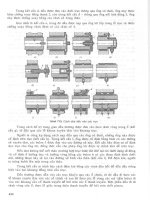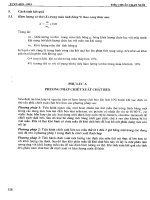MARKETING RESEARCH PART 8 pot
Bạn đang xem bản rút gọn của tài liệu. Xem và tải ngay bản đầy đủ của tài liệu tại đây (156.68 KB, 33 trang )
Observation, Focus
Groups, and Other
Qualitative Measures
Ch 8 2
Categories of Research
• Quantitative research: research
involving the use of structured
questions in which response options
have been predetermined and a large
number of respondents involved
• Qualitative research: research
involving collecting, analyzing, and
interpreting data by observing what
people do and say
Ch 8 3
Categories of Research
• Pluralistic research: combination of
both quantitative and qualitative
research methods in order to gain the
advantages of both
Ch 8 4
Observation Techniques
• Observation methods: techniques in
which the researcher relies on his or
her powers of observation rather than
communicating with a person in order
to obtain information
Ch 8 5
Observation Techniques
• Types of observation:
–Direct versus indirect
–Disguised versus undisguised
–Structured versus unstructured
–Human versus mechanical
Ch 8 6
Observation Techniques
Direct versus Indirect
• Direct observation: observing
behavior as it occurs
• Indirect observation: observing the
effects or results of the behavior
rather than the behavior itself
–Archives
–Physical traces
–Structured versus unstructured
–Human versus mechanical
Ch 8 7
Observation Techniques
Disguised versus Undisguised
• Disguised observation: subject is
unaware that he or she is being
observed
• Undisguised observation: respondent
is aware of observation
Ch 8 8
Observation Techniques
Structured versus Unstructured
• Structured observation: researcher
identifies beforehand which behaviors
are to be observed and recorded
• Unstructured observation: no
restriction is placed on what the
observer would note: all behavior in
the episode under study is monitored
Ch 8 9
Observation Techniques
Human versus Mechanical
• Human observation: observer is a
person hired by the researcher, or,
perhaps the observer is the
researcher
• Mechanical observation: human
observer is replaced with some form
of static observing device
Ch 8 10
Observation Techniques
Appropriate Conditions for Use
• Short duration
• Public
• Faulty recall conditions
Ch 8 11
Observation Techniques
Advantages of Observational Data
• Insight into actual, not reported,
behaviors
• No chance for recall error
• Better accuracy
• Less cost
Ch 8 12
Observation Techniques
Limitations of Observational Data
• Small number of subjects
• Subjective interpretations
• Inability to pry beneath the behavior
observed
• Motivations, attitudes, and other
internal conditions are
unobserved…we don’t know why?
Ch 8 13
Home Depot: An Example of
Direct Observation
Shopper/Store Use Profile
Average time in store: 32.4 (minutes)
Customer party size: 1.2 (persons)
Average expenditures: 57.34 (dollars)
Payment method 73.0% (credit card)
Number of aisles traveled: 5.7
Requests for assistance: 0.5
Stops and looks at items 5.4
Items handled per stop 2.1
Total items handled 9.3
Items purchased 2.5
Product Categories of
Purchases
Appliances 10%
Hand tools 22%
Electrical 31%
Plumbing 14%
Roofing 3%
Garden 35%
Other 26%
We know WHAT
BUT, We don’t know WHY!
Ch 8 14
Focus Groups
• Focus groups are small groups of
people brought together and guided
by a moderator through an
unstructured, spontaneous
discussion for the purpose of gaining
information relevant to the research
problem.
Ch 8 15
Focus Groups
• The moderator’s task is to ensure
that open discussion is “focused” on
some area of interest.
• Focus groups are used to generate
ideas, to learn the respondents’
“vocabulary,” to gain some insights
into basic needs and attitudes.
Ch 8 16
Types of Focus Groups
• Traditional: Select 6 to 12 persons
and meet in a dedicated room with
one-way mirror for client viewing, for
about two hours.
Ch 8 17
Types of Focus Groups
• Nontraditional: Online with client
viewing from distant locations; may
have 25 or even 50 respondents;
allow client interaction; may take place
in nontraditional locations.
• Online focus groups are a form of
nontraditional focus groups.
Ch 8 18
Focus Groups
Online Focus Groups
• Online focus group: one in which the
respondents and/or clients
communicate and/or observe by use
of the Internet
Ch 8 19
Focus Groups
Online Focus Groups
• Advantages:
–No physical setup is necessary
–Transcripts are captured on file in
real time
–Participants can be in widely
separated geographical areas
–Participants are comfortable in their
home or office environments
–The moderator can exchange
private messages with individual
participants
Ch 8 20
Focus Group Facility Floor
Plan
Source: Market Trends (www.markettrends.com)
Ch 8 21
Pros of Focus Groups
• Generate fresh ideas
• Allow clients to observe their
participants
• May be directed at understanding a
wide variety of issues
• Allow fairly easy access to special
respondent groups
Ch 8 22
Cons of Focus Groups
• Representativeness of participants
• Interpretation sometimes difficult
• High cost per participant
Ch 8 23
The Proper Use of Focus
Groups
• Focus groups should not be used
when the research objective is to
predict a specific number based upon
sample data.
Ch 8 24
The Proper Use of Focus
Groups
• Focus groups should be used when
the research objective is to describe
rather than predict.
–How do consumers describe a
better package?
–How would they describe their
satisfaction with our service?
–How could they describe their
ideas for an ad campaign?
Ch 8 25
Operational Issues of Focus
Groups
• Size: 6 to 12
• Who: homogeneous
• Recruiting: use incentives
• Selection: what is purpose?
• Where: conducive to group
discussion
• When moderator gets involved: early
• Reporting results: report qualitative
data









